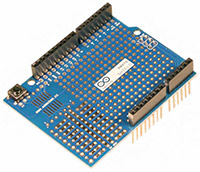By Arduino 113

Arduino and Arduino-compatible boards make use of shields, expansion boards that plug into the normally supplied Arduino pin-headers. The different shields follow the same philosophy as the original toolkit: they are easy to mount and easy to use. Shields can provide additional functionality to an Arduino board, including motor control, GPS, Ethernet, LCD display, and bread boarding (prototyping).
The Arduino Ethernet shields connect your Arduino to the internet in mere minutes. Just plug this module onto your Arduino board, connect it to your network with an RJ45 cable (not included), and follow a few simple instructions to start controlling your world through the internet. As always with Arduino, every element of the platform - hardware, software, and documentation - is freely available and open-source. This means you can learn exactly how it is made, and use its design as the starting point for your own circuits.
The Wireless SD shield allows an Arduino board to communicate wirelessly using a wireless module. It is based on the Xbee modules from Digi, but can use any module with the same footprint. The module can communicate up to 100 feet indoors or 300 feet outdoors (with line-of-sight). It can be used as a serial/USB replacement, or it can be put into a command mode and configured for a variety of broadcast and mesh networking options. The shields breaks out each of the Xbee's pins to a through-hole solder pad. Included on board is a SD card slot. When using the SD library to access the card, pin 4 is CS and cannot be used otherwise. SPI also relies on pins 11, 12, and 13 for communication. An on-board switch allows the wireless module to communicate with the USB-to-serial converter or with the microcontroller.